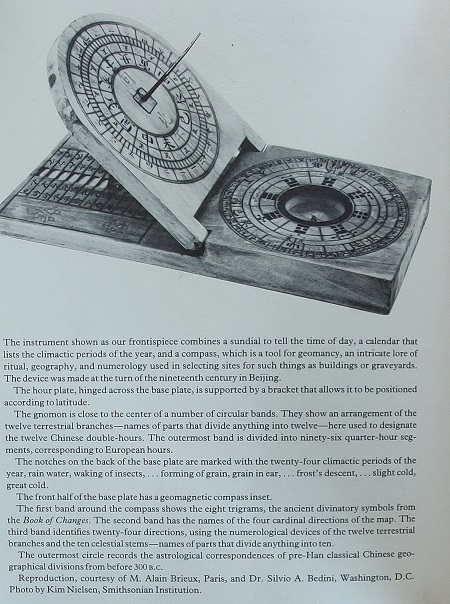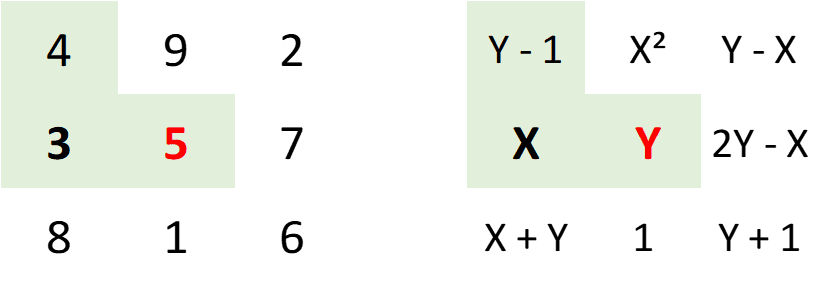The instrument most responsible for the advancement of humankind was the gnomon, also known as the carpenter’s square. The most advanced societies in early civilization could be associated with the use of the gnomon that in turn, would identify a functional calendar. As a result, the Egyptians and the Chinese would have the the most advanced agricultural communities that would lead to prosperity and evolution.
The first
printed page of the wondrous Science and Civilisation in China (Joseph
Neeham, 1959) encapsulates the totality of early Chinese cosmology:
The
carpenter’s square is no ordinary tool, but the gnomon for measuring the
lengths of the sun's solstitial shadows.
The circle (heaven), the square (the earth), the measurement of time and space, and the astronomical instruments that help to connect humankind with heaven are important concepts that lead to the symbols used by the ancients in ceremony, art, and architecture.
The
carpenter’s square, or gnomon, was the first instrument to document evidence of
the sun’s light (and the resultant shadows), thus becoming humankind’s first
instrument for determining and preserving images of the passage (or numbers) of
time. The oldest known gnomon dates to about 3,500 - 2,300 BC (Egypt and China), sixteen hundred
years ahead of the Greeks and Western civilization. Prior to the gnomon, there
was no method of interpreting celestial signs, and time had no image to
measure.
The shadow became the image of the means to measure time, and thus from its first use, the upright gnomon enabled such measurement. The daily measurement of the shadow for thousands of years became a tradition of moral behavior etched into the daily lives of the early Chinese such that the instruments and mathematics involved became part of the symbols and numerology used in art, language, and ceremony. (from The Secret of the Magic Square, Robert Dickter, 2025).
Image
1. Measuring the sun’s shadow length at summer solstice with a gnomon and a
gnomon shadow template. (Image from Number Time Archetype, Robert Dickter, 2014).
The
carpenter’s square is symbolic of the gnomon and, in some cases, the two terms
can be used interchangeably. Its role in measuring the heights and distances of
the universe as well as an astronomical instrument that helps measure time make
the carpenter’s square / gnomon critical to the rise of civilization. The
carpenter’s square represents the wisdom of the right-angle triangle and evokes
the promise of establishing order on earth.
This is
why the symbolism of the carpenter’s square / gnomon plays an integral part in the origins of early
Christian art and architecture. The consistent use of this symbol demonstrates
the importance the early Christian hierarchy placed on the role of math and the
measurement of time.
Let us
know examine the use of the carpenter’s square / gnomon in art and architecture
throughout the history of an evolving civilization, whether it be in ancient Egypt, early
China, or the West.
Egypt, 1504 to 1425, BC
Early China, 140 AD to 689 AD
Image 3. Two examples of the legendary sage Fu Xi holding the carpenter’s square and
his wife / sister Nu-wa holding the compass. The example of the left was etched
into the walls of the Wu Liang tombs, c. 140 AD. The example on the right is
from a silk veil found in the tomb of Fan Yen-Shih, 689 AD, and again reflects
the image of Fu Xi and Nu-wa.
Fu Xi and Nu-wa are mythological characters that represent the first ancestors of the Chinese, a legacy that is over four thousand years old. The yin-yang relationship of the male who rules heaven holds the set square which represents earth, as the female who rules the earth holds the compass which represents heaven. In language, the Chinese character for carpenter's square ju, 矩, when combined with the Chinese character for compass gui, 規, forms a new word, gui ju, 規矩, which means to establish order, a moral code, or the way things should be. It literally means the compass and square. This might be the instance that the symbol for carpenter's square and compass evoked the concept of moral behavior as well as establishing order from chaos via the implementation of wisdom, or mathematics. The word gnomon in Greek also means "one who knows, a rule of faith or conduct". The Chinese word ju (chu) means gnomon / carpenter's square, a rule, pattern, usage, a custom. Both have similar meanings and concepts that relate the usage of an astronomical instrument that can identify the passage of time to wisdom and a moral standard. Ancient China began using the gnomon about 2300 BC.
The
Middle East
Cave of
Letters, C. 130 AD
The earliest usage
of the carpenter’s square (as a religious symbol) represented by the gammadia, from gamma, a Greek
letter in the shape of a right angle, is attributed to the Jewish religion. This
art motif would appear on garments found in a cave from the Dead Sea discovered
in 1966. In the Bar Kokhba Cave scrolls and many old and well-preserved
garments worn by especially holy initiates of the Jewish religion were
discovered. The art motif known as the gammadia would be used for hundreds of
years in early Christian art and architecture.
Syria
Dura
Europos Synagogue and Church, c. 245 AD
Here one
can find the coexistence of the Jewish and Christian communities in the Roman
world.
Image 4. Paintings on the walls of the Dura Europos synagogue demonstrating the gamma
or carpenter’s square motif on female garments.
Dura Europos was founded in about 300 BC, an ancient city on the Euphrates River in modern-day Syria. The city became a cultural melting pot of Greeks, Romans, Syrians, Jews and Christians before Christianity became the dominant religion.
The
Oriental Influence on Early Christian Art and Architecture
Theodoric’s Mausoleum, 520 AD
Image 5. Theodoric’s Mausoleum, Ravenna, Italy. The use of the carpenter’s square in
architecture with the names of the twelve apostles etched onto each right
angle.
Ravenna, Italy, 525 – 85O AD
Image 6. The carpenter’s square usage on mosaics, c. 525 AD. On the right, four
apostles and Christ blessing the loaves and fish, Sant’ Apollinare Nuovo,
Ravenna. On the left, The Sacrifices of Abel and Melchizedek, c. 540
AD, in the Basilica of San Vitale, Ravenna.
The gammadia
was used to identify people, architecture, or objects of religious importance. The
art motif was an important symbol that emphasizes wisdom (math) that
corresponds to establishing order, one who knows, and a moral standard. The symbol can be
found on garments worn by the especially initiated such as the twelve apostles,
books such as illuminated manuscripts, buildings such as temples and basilicas,
altar cloths, and mosaics that adorned the early churches. There are literally
hundreds of examples of this usage form the Middle Ages in dozens of churches.
Now that
we have established the origin and use of the carpenter’s square as an iconic
symbol, let us now look at some of the world’s greatest artists who recognized
the significance of the carpenter’s square as an example of Pythagorean
philosophy: that numbers, weight and measurement help to explain and bring
order to the material world we live in.
The Carpenter’s Square Used in Art, 1514 to 1919
Image 7. Albrect Durer’s Melancholia I (1514) with the compass, set square, and numerous references to mathematics and geometry, including the magic square, also a symbol of establishing universal order thru the implementation of math.
Image 8. Hans Holbein, The Ambassadors (1533) also demonstrating many references to math and astronomy. Note the carpenter’s square is holding a place in a math book by Peter Apian, A New and Well-grounded Instruction in All Merchants’ Arithmetic (1527).
Image 11. William Blake’s The Ancient of Days (1734) and Christ in the Carpenters Shop (1805) also emphasize religion and mathematical instruments that connect wisdom with the tools of geometry.
Image 12. Salvadore Dali’s Leda Atomica (1949) follows a strict mathematical template
that emulates the divine proportion (the golden ratio) featuring the carpenter’s
square once again.
Image 13. Detail of book. The cover exhibits quincuncial composition: the four corners are small squares representing earth, the five rectangles form a cruciform shape representing heaven, the center has the classic circle within a square representing the axis mundi, or the meeting of heaven and earth. The central rectangle meets the measurements that reflect the golden ratio, 1.6.
History
and wisdom merge when science and math are incorporated into art and
architecture. The early Chinese recognized this and used these concepts in city design, tomb design, and to identify buildings and things of political and religious importance. In this regard, the origin of early Christian church art and architecture
has a decidedly oriental influence. Artists throughout history have carried the
burden of educating the masses as to the importance of science and math. In
this way, the story of civilization lives on thru the use of symbols such as
the carpenter’s square, compass, and the magic square.






































